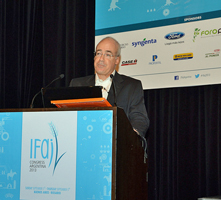 Registration is now open for AgGateway’s 2013 Annual Meeting and Conference, “Collaboration for eConnectivity – Ensuring Success for the Future”, to be held November 11-14 at the Renaissance Vinoy Resort and Golf Club in St. Petersburg, Fla.
Registration is now open for AgGateway’s 2013 Annual Meeting and Conference, “Collaboration for eConnectivity – Ensuring Success for the Future”, to be held November 11-14 at the Renaissance Vinoy Resort and Golf Club in St. Petersburg, Fla.
AgGateway’s eighth annual conference is expected to draw record attendance again this year, as hundreds of business and IT professionals from across the ag industry meet to discuss ongoing successes in implementing eBusiness between agricultural trading partners. Attendance at the conference has doubled in the past three years. AgGateway currently has more than 180 member companies working collaboratively on eBusiness projects within nine major ag industry segments.
Register by October 2 to take advantage of early bird registration discounts, as well as the chance to win a free upgrade to a suite at the Renaissance Vinoy. A discounted hotel rate of $169 per night is available at the Vinoy until October 9.










 The recently announced SMS Water Management Module from Ag Leader boasts a variety of features to help take the guesswork out of planning a tile system. So what are some of the new enhancements?
The recently announced SMS Water Management Module from Ag Leader boasts a variety of features to help take the guesswork out of planning a tile system. So what are some of the new enhancements?